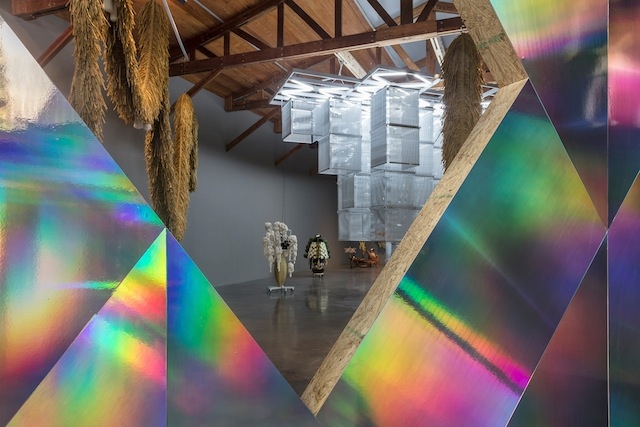Kurimanzutto, Mexico City, 1 April – 6 May
Haegue Yang’s first solo exhibition in Mexico reveals the artist’s fervent intention to present a full view of her various practices. It includes her iconic Venetian blinds installation, The Intermediate sculpture series (2015–) and graphic wall pieces. When you walk around or through her largescale blinds installation Sol LeWitt Upside Down – K123456, Expanded 1078 Times, Doubled and Mirrored (2015), you encounter perfumes coming from aroma diffusers, which will remind you of the artist’s frequent use of air and smell in her earlier works.
Surprisingly, given the variety of visual features in these works, there is little conflict in seeing them placed together in one space. As stated in the title, the exhibition highlights ornament and abstraction, two seemingly conflicting directions in Yang’s practice. But the show is not so much a juxtaposition of these two interests as a survey of the dialectic relationship between them. From a modernist point of view, ornament, or decoration, was a premodern inclination, criticised and abandoned by those who believed in progress, as can be seen in architect Adolf Loos’s 1908 essay ‘Ornament and Crime’. A result of this is that abstraction replaced ornament and became the ‘correct’ direction in art and design during the twentieth century. Yang, who has always been interested in traditional materials, figures and craftsmanship, must have seen the fusion of folk elements, symbolism and ornaments with modern art in Mexican murals from that time (even in the service of a radical socialist ideology, as was the case in Diego Rivera’s mural work), which then inspired her critical thinking on the stigmatisation of ornament.
At a deeper level, the logic behind the stigmatisation of ornament is ethnology, a sociocultural science whose mission at its birth was to classify humans and their civilisations through a Eurocentric point of view and therefore was once used as a theoretical source to the colonist ideology. Ironically, in the modernist time, those who held this view of progress never really abandoned decoration, not even Loos, who used expensive materials such as marble or brass to create a sort of luxury decoration in his architecture, one made of geometrical and mechanic abstraction. With this in mind, it becomes evident that the material and cultural references used in Yang’s work, for example the (cheap) synthetic materials and saekdong (traditional Korean clothing) in the Intermediate series, are meant to challenge the modernist aesthetic and moral principles, and perhaps ultimately to aim at the logic behind the stigmatisation of ornament.
More than restoring the meaning of ‘ornament’, Yang is exploring the possibilities of embracing it in contemporary visual art. Her recent wallpaper pieces, for example Big-eyed Tongue-tied Mountains Beneath Solar and Lunar Orbs – Trustworthy #315 and Pregnant Mountains – Trustworthy #316 (both 2017), incorporate symbolist ornament into geometrical and graphic abstraction to create landscapes that are reminiscent of Mexican mural art, perhaps especially Juan O’Gorman’s Central Library facade at the National Autonomous University of Mexico. If the form and meaning of modernity depend on when and where we stand, these works derive their form and meaning from an artist standing on Mexican land and travelling through history via research. In my eyes, they are the most charming pieces in the show.
From the Summer 2017 issue of ArtReview Asia
